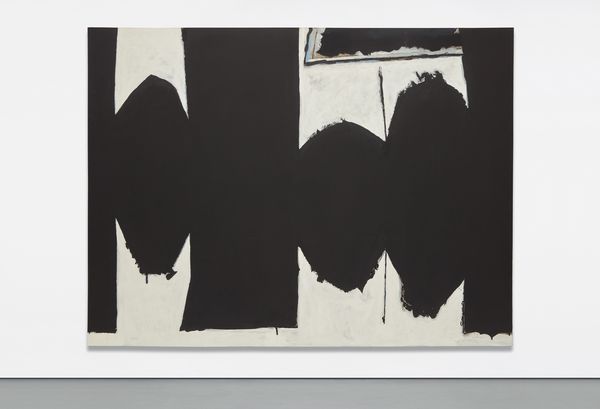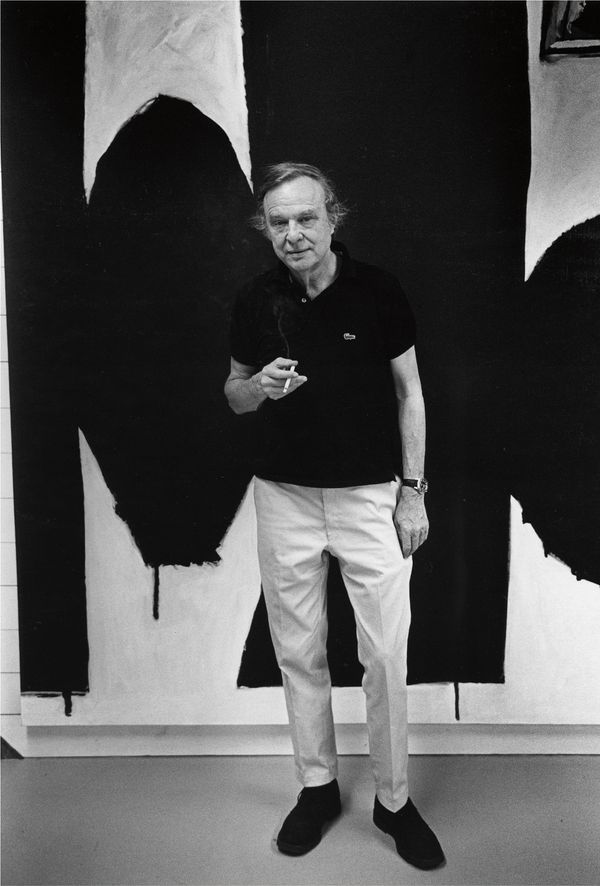Robert Motherwell At Five in the Afternoon, 1971
Carter Ratcliff is a Contributing Editor at Art in America and the author of The Fate of a Gesture: Jackson Pollock and Postwar American Art. This is an excerpt from Ratcliff's 'A Field of Inexhaustible Meaning'.
Generating its power from contrasts at once stark and elegantly interwoven, Robert Motherwell's At Five in the Afternoon, 1971, is among a handful of canvases crucial to the definition of Abstract Expressionism. As black and white find a complex equilibrium, geometry at its most austerely angular comes to terms with gesture at its most lushly organic. Grandeur draws strength from minute inflections. At Five in the Afternoon is a formal masterpiece, yet it is not an exercise in "pure painting" of the kind that certain modernists have sought since the 1890s. Motherwell described painting as a "search" not only "for beauty or artfulness, but an attitude toward reality."
A brilliant writer with a background in literature and philosophy, Motherwell believed that "reality has a historical character." He made this Hegelian principle his own by insisting that a pictorial possibility could be realized only over time, in successive paintings. Having established a theme, he would put it through the variations that produced such series as Open, Je t'aime and Night Music. Of these, Elegy for the Spanish Republic is the most extensive. Over two-hundred and fifty works, from small-scale works on paper to monumental canvases—including the At Five in the Afternoon paintings—fall under this heading. Reflecting Motherwell's era at every scale from the personal to the world-historical, the Elegies are endlessly resonant. For it is here that his deepest concerns are the most powerfully felt, and, in the 1971 version of At Five in the Afternoon, the artist's feelings are given their fullest expression.
Reflecting Motherwell's era at every scale from the personal to the world-historical, the 'Elegies' are endlessly resonant.
Robert Motherwell with At Five in the Afternoon, in progress, 1970. Image © Dedalus Foundation, Artwork © Dedalus Foundation/Licensed by VAGA NY, NY
Referring to the hour at which bullfights traditionally begin, the painting's title is taken from Federico García Lorca's Lament for Ignacio Sánchez Mejías, a poem commemorating, with horror and exalted sorrow, a matador's fatal goring in 1934. Two years later, Lorca was assassinated. Though his killers have never been identified, it is widely agreed that they were right-wing operatives who targeted him for his support of the Spanish Republic and possibly because he was a homosexual. Underway by then, the Spanish Civil War ended in 1939 when a fascist coalition crushed its badly divided opposition. Francisco Franco became the head of a dictatorship that persisted until 1975. Twenty-one years old when the Civil War broke out, Motherwell felt a deep and immediate sympathy for those struggling to establish the Spanish Republic. Learning of their defeat, he underwent a corresponding shock.
The artist produced his first Elegy to the Spanish Republic in 1948. Executed in India ink on a small sheet of paper, it deploys three columns and three ovals. In the upper-right corner is a fragment of what may be a window frame. Appearing in the aftermath of the Second World War, this painting urges us to see the civil conflict in Spain as the prelude to a century of atrocities. The Spanish Republic, in its demise, becomes a symbol of humane hope. Motherwell reprised the 1948 Elegy a year later. Naming it At Five in the Afternoon, he gave the dimension of an individual life to a widely inclusive symbol. The life in question is that of the slain bullfighter, Sánchez Mejías. However, we could see the exemplary figure as the poet Lorca. Or, as Motherwell himself wrote in "The Modern Painter’s World" in 1940, "the history of modern art tends at certain moments to become the history of modern freedom." One of those moments occurred in 1949, triggered by the personal crisis that drove the artist to reprise his first Elegy and name the new painting At Five in the Afternoon. In 1971, the crisis recurred.
Motherwell married the painter Helen Frankenthaler in 1958, bringing to their union the 1949 version of At Five in the Afternoon. When they divorced in 1971, their settlement allowed her to keep the painting. Devastated by the loss of a work of such intensely personal significance, he decided to recreate it on a canvas ten feet wide and seven and a half feet high. The painting was going well until his mood suddenly changed. As he recalled the following summer, "I began to feel suicidal." "Terribly upset," he asked, "What am I hiding from myself?" Only after a long bout of anguished rumination did the answer come to him. He had made the earlier At Five in the Afternoon when his first wife, the Mexican actress Maria Ferriera y Moyers, left him. Working on that painting, he had "seriously considered suicide," and thoughts of killing himself returned as he remade the painting 22 years later.
Robert Motherwell At Five in the Afternoon, 1948–1949. Collection of Helen Frankenthaler, Artwork © Dedalus Foundation/Licensed by VAGA, NY, NY
Independence, he realized, could be felt as unbearable isolation. Reprising At Five in the Afternoon in 1971, Motherwell felt himself drawn to the verge of self-destruction—and then back from that ultimate precipice. For, in finishing the painting, he reclaimed his best sense of himself.
Talking to David Sylvester in 1960, the artist said, "The process of painting is a series of moral decisions about the aesthetic." He did not, he added, mean this "in a puritanical sense…but almost primitively, as a kind of animal thirst for something solidly real." Of course, he wanted his paintings to "work" pictorially, as the New York painters began saying in the 1940s. Yet Motherwell was never satisfied with a narrow aesthetic success. Hence the Elegies. Recalling the horrors perpetrated in the name of ideology, these paintings immerse us in a felt sense of our shared history. And, as they point beyond our collective destiny to the fate of an individual, the Elegies entitled At Five in the Afternoon turn the dead matador of Lorca's Lament into an emblem of the death that Motherwell, in moments of suicidal despair, hoped for himself. By completing the two paintings, he twice found his way beyond that despair to the generative power that charges every detail of Motherwell's. paintings with manifold meanings. For At Five in the Afternoon, especially the version from 1971, is haunted by more than the bullring’s fatal ritual.
Read more about this masterwork here prior to the occasion of its sale during our New York Evening Sale.


